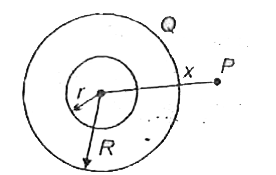Equal charges are given to two spheres of different radii. The potential will
be more on the smaller sphere
be more on the bigger sphere.
be equal on both the spheres.
depend on the nature of the materials of the spheres.
The correct Answer is:A
Step by step video, text & image solution for Equal charges are given to two spheres of different radii. The potential will by Physics experts to help you in doubts & scoring excellent marks in Class 12 exams.
Updated on:21/07/2023Topper's Solved these Questions
- ELECTROSTATICSBOOK - TARGET PUBLICATIONCHAPTER - ELECTROSTATICSEXERCISE - COMPETITIVE THINKING
124 Videos
- ELECTROSTATICSBOOK - TARGET PUBLICATIONCHAPTER - ELECTROSTATICSEXERCISE - EVALUATION TEST
14 Videos
- ELECTROSTATICSBOOK - TARGET PUBLICATIONCHAPTER - ELECTROSTATICSEXERCISE - EVALUATION TEST
14 Videos
- ELECTROMAGNETIC INDUCTIONBOOK - TARGET PUBLICATIONCHAPTER - ELECTROMAGNETIC INDUCTIONEXERCISE - EVALUATION TEST
8 Videos
- GRAVITATIONBOOK - TARGET PUBLICATIONCHAPTER - GRAVITATIONEXERCISE - EVALUATION TEST
24 Videos
Similar Questions
Consider tow concentric conducting spheres of radii a &b(b>a). Inside sphere has a positive charge q1. What charge should be give to the ouer sphere so that potential of the inner sphere becomes zero ? How does the potentila varies between the two spheres & outside ?
View SolutionConcentric metallic hollow spheres of radii R and 4R hold charges Q1andQ2 respectively. Given that surface charge densities of the concentric spheres are equal, the potential difference V(R)−V(4R) is :
View Solution
Knowledge Check
Equal charges are given to two sphere of different radii . The potential will
Abe more on the smaller sphereBbe more on the bigger sphereCbe equal on both the sphereDdepend on the nature of the material of the sphereAssertion: The surface charge densities of two spherical conductors of different radii are equal. Then the electric field intensities near their surface are also equal.
Reason: Surface charge density is equal to charge per unit area.Aif both Assertion and Reason are true and the Reason is correct explanation of the Assertion.BIf both Assertion and Reason are true but Reason is not the correct explanation of the Assertion.Cif Assertion is true, but the Reason is false.Dif both Assertion and Reason are falseA charge Q has been divided on two concentric conducting spheres of radii R1 and R2(R1>R1) such that the surface charge densities on both the spheres are equal. The potential at their common centre is
A14πε0Q(R21+R22)(R1+R2)B14πε0Q(R1+R2)(R21+R22)C14πε0QR1R2(R1+R2)D14πε0Q(R1R2)R1R2
Two identical sphres, one positively charged and the other negativily charged are held d cm apart.If the magnitude of the charges on the two spheres are equal , find the electric potential at a point midway on the line joining the centres of the two spheres.
View SolutionEquipotential spheres are drawn round a point charge. As we move away from charge will the spacing between two spheres having a constant potential difference decrease, increase or remain constant.
View SolutionTwo concentric hollow conducting spheres of radius r and R are shown. The charge on outer shell is Q. what charge should be given to inner sphere so that the potential at any point P outside the outer sphere is zero ?

View SolutionTwo spheres of radii R1 and R2 have equal charge are joint together with a copper wire. If the potential on each sphere after they are separated to each other is V, then initial charge on any sphere was (k=14π∈0)-
View SolutionA solid conducting sphere of radius a is enclosed in a concentric shell of radius b>a. The charge on the inner sphere is 3μC and on the conducting shell is −10μC. The potential difference between the conductors is V. If +10μC additional charge is given to the outer shell, the new potential difference is
View Solution
